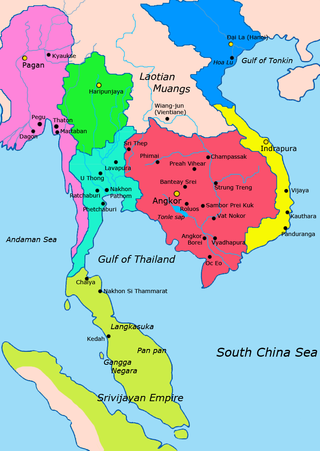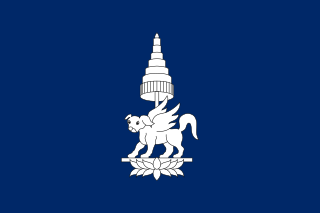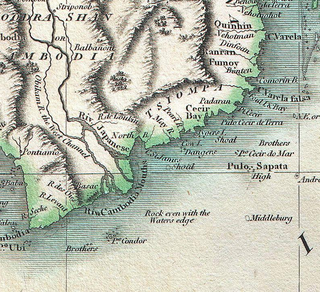Related Research Articles

Champa was a collection of independent Cham polities that extended across the coast of what is contemporary present-day central and southern Vietnam from approximately the 2nd century AD until 1832, when the last remaining principality of Champa was annexed by the Vietnamese Nguyễn dynasty under its emperor Minh Mạng as part of its expansionist Nam tiến policy. The kingdom was known variously as Nagaracampa, Champa (ꨌꩌꨛꨩ) in modern Cham, and Châmpa (ចាម្ប៉ា) in the Khmer inscriptions, Chiêm Thành in Vietnamese and Zhànchéng in Chinese records.

The Lao Kingdom of Lan Xang Hom Khao existed as a unified kingdom from 1353 to 1707.
Chao Anouvong, or regnal name Xaiya Setthathirath V, , led the Lao rebellion (1826–28) as the last monarch of the Kingdom of Vientiane. Anouvong succeeded to the throne in 1805 upon the death of his brother, Chao Inthavong, Xaiya Setthathirath IV, who had succeeded their father, Ong Bun or Phrachao Siribounyasan Xaiya Setthathirath III. Anou was known by his father's regal number until recently discovered records disclosed that his father and brother had the same regal name.

Muang Sua was the name of Luang Phrabang following its conquest in 698 CE by a Tai/Lao prince, Khun Lo, who seized his opportunity when the king of Nanzhao was engaged elsewhere. Khun Lo had been awarded the town by his father, Khun Borom, who is associated with the Lao legend of the creation of the world, which the Lao share with the Shan and other peoples of the region. Khun Lo established a dynasty whose fifteen rulers reigned over an independent Muang Sua for the better part of a century.

Jayavarman VII, posthumous name of Mahaparamasaugata, was king of the Khmer Empire. He was the son of King Dharanindravarman II and Queen Sri Jayarajacudamani. He was the first king devoted to Buddhism, as only one prior Khmer king was a Buddhist. He then built the Bayon as a monument to Buddhism. Jayavarman VII is generally considered the most powerful of the Khmer monarchs by historians. His government built many projects including hospitals, highways, rest houses and temples. With Buddhism as his motivation, King Jayavarman VII is credited with introducing a welfare state that served the physical and spiritual needs of the Khmer people.
The precedence of Thai royalty follows a system of ranks known as thanandon, which are accompanied by royal titles.

Somdet Chaophraya Borom Maha Sri Suriwongse, whose personal name was Chuang Bunnag, was a prominent 19th century Thai figure who served as the regent during the early years of the reign of King Chulalongkorn.

The Kingdom of Champasak or Bassac, (1713–1904) was a Lao kingdom under Nokasad, a grandson of King Sourigna Vongsa, the last king of Lan Xang and son-in-law of the Cambodian King Chey Chettha IV. Bassac and the neighboring principalities of Attapeu and Stung Treng emerged as power centers under what was later to be described as the Mandala Southeast Asian political model.

Suwannaphum is a district (amphoe) of Roi Et province, in eastern Thailand. It is named after the legendary country of Suwannaphum, which according to Thai tradition was on the Chao Phraya plain. It was the seat of a small Lao mandala kingdom until the Laotian Rebellion of 1826-1829 ended vestiges of Lao independence west of the Mekong.

The Lao Rebellion of 1826–1828 was an attempt by King Anouvong of the Kingdom of Vientiane to end the suzerainty of Siam and recreate the former kingdom of Lan Xang. In January 1827 the Lao armies of the kingdoms of Vientiane and Champasak moved south and west across the Khorat Plateau, advancing as far as Saraburi, just three days march from the Siamese capitol of Bangkok. The Siamese mounted a counterattack to the north and east, forcing the Lao forces to retreat and ultimately taking the capital of Vientiane. Anouvong failed in both his attempt to resist Siamese encroachment, and to check the further political fragmentation among the Lao. The kingdom of Vientiane was abolished, its population was forcibly moved to Siam, and its former territories fell under the direct control of Siamese provincial administration. The kingdoms of Champasak and Lan Na were drawn more closely into the Siamese administrative system. The kingdom of Luang Prabang was weakened but allowed the most regional autonomy. In its expansion into the Lao states, Siam overextended itself. The rebellion was a direct cause of the Siamese-Vietnamese wars in the 1830s and 1840s. The slave raids and forced population transfers conducted by Siam led to a demographic disparity between the areas that would ultimately become Thailand and Laos, and facilitated the "civilizing mission" of the French into Lao areas during the latter half of the nineteenth century.
Setthathirath II, also called Ong Lo and Sai Ong Hue, grandson of the great ruler Suliyavongsa, was the king of the Lao Kingdom of Lān Xāng. In Vietnamese records, he was called Triều Phúc (朝福).
Bhadravarman or Phạm Hồ Đạt, was the king of Champa from 380 to 413. In 380, Bhadravarman, the son or grandson of Fan Fo, took the throne with the regal name Dharmamahārāja Śrī Bhadravarman I, "Great King of the Law Bhadravarman".
Harshavarman III was a king of Khmer who ruled from 1066 to about 1080 AD. He succeeded his elder brother Udayadityavarman II and his capital was the so-called Second Yasodharapura, which had its center in Baphuon, built by his brother, and West Baray as its principal bàrày. He was married to queen Kambujarajalakshmi.

Panduranga or Prangdarang was a Cham Principality and later, the rump state successor of the Champa kingdom, which was destroyed by Vietnamese emperor Le Thanh Tong in 1471. It was located in present-day Southcentral Vietnam. It stood until late 17th century as the Nguyễn lords of Đàng Trong, a powerful Vietnamese clan, vassalized it and put the Cham polity under the name Principality of Thuận Thành.
Kandarpadharma was the King of the Simhapura dynasty of Champa. He ruled from 629 to an unknown date, when he was succeeded by his son, King Prabhasadharma. His rule was peaceful and he sent two missions to China in 630 and 631.

Following the Sack of Ayutthaya and the collapse of the Ayutthaya Kingdom (1351–1767) during the Burmese–Siamese War (1765–1767), a power vacuum left Siam divided into 5 separate states—Phimai, Phitsanulok, Sawangburi, Nakhon Si Thammarat, and Thonburi. The state of Thonburi, led by Taksin, would ultimately prevail, subjugating its rivals to successfully reunify Siam under the Thonburi Kingdom (1767–1782) by 1770/71.

Vikrāntavarman I or Prakāśadharma, was a king of Champa from the Gangaraja (Simhapura) dynasty, modern-day Central Vietnam, reigning from 653 to 686. His original name was Prakāśadharma but he took the appellation Vikrāntavarman when he was crowned in 653. He was the son of Prince Jagaddharma, the grandson of Kandarpadharma, and Princess Sarväpi, daughter of king Isanavarman I of Zhenla. He sent embassies to the court of Emperor Gaozong of Tang in 653, 654, 669, and 670, which he was known as Zhu Ghedi (諸葛地) and Bojiashebamo, as recorded in the New Book of Tang. He was known for expanding the Champa kingdom to the south, uniting the realm under one dynasty.
Jaya Paramesvaravarman I, personal name Īśvaramūrti, was a king of Champa, reigning from 1044 to 1060. He founded a dynasty that centralized around Nha Trang and Phan Rang, which would dominantly rule mandala Champa until 1074.
Champa Si Ton is a folktale from the Lao people.
References
- ↑ Brow, James (1976), "Population, land and structural change in Sri Lanka and Thailand", Contributions to Asian Studies, Kogan Page, Limited (9): 47, ISBN 90-04-04529-5
- ↑ Buyers